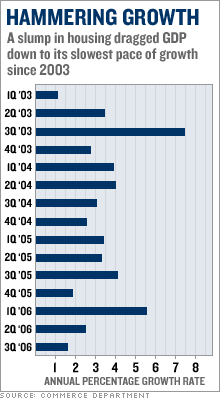|
Economy weakest in three years GDP grew at a 1.6 percent rate in third quarter, down from 2.6 percent in the second; inflation gauge retreats. NEW YORK (CNNMoney.com) -- Economic growth slowed to the weakest pace in more than three years in the third quarter, as the government's main gauge of the strength of the U.S. economy came in much lower than analysts had forecast. Gross domestic product (GDP), the broadest measure of the nation's economy, grew at a 1.6 percent annual rate in the quarter, the Commerce Department said, down from the 2.6 percent rate in the second quarter.
Economists surveyed by Briefing.com had forecast a slowdown to 2.1 percent. While the slower than expected economic growth isn't a positive, some economists argued the economy appears poised to bounce back in the current quarter, helped by lower energy prices. Moreover, the slower growth, and a price reading in the report that showed less inflation pressures than expected, raised hopes that the Federal Reserve could start to cut interest rates early next year, as the central bank tries to find the balance between economic growth and price stability. Weaker growth in the quarter was attributable in part to a rising trade gap, which subtracts from GDP, as well as a slump in the nation's housing market. Consumer spending also came in a bit weaker than expected. The news was not well timed for the Bush administration as Republicans try to hold onto Congress as polls show the Democrats poised to make gains. While the war in Iraq has held much of the focus of the election debate, and other key parts of the economy, notably the stock market and employment, are still relatively strong, the Democrats were quick to seize on the GDP report as a further sign of problems in administration policy. "Once again, the Bush economy is going in the wrong direction," said a statement from Rep. Carolyn Maloney, D-N.Y., the senior House Democrat on the Joint Economic Committee. "An economic recovery that never benefited working Americans in the first place now has slowed to a crawl." More than two hours after the release of the GDP report, the press offices for the White House, the Commerce Department and the Treasury Department said that they had no statement on the report. On Wall Street, stocks fell modestly after the report, on the heels of a string of record highs for the Dow Jones industrial average. Treasury bond prices rose on the news, trimming the yield on the 10-year note to 4.69 percent, as investors bet that inflation is in check. The report's closely watched inflation reading, the so-called core PCE deflator that measures of prices paid by consumers for goods other than food and energy, climbed at a 2.3 percent rate in the quarter, down from 2.7 percent in the second quarter. Some economists had been looking for a 2.5 percent rate, and the 2.3 percent rate is closer to the 2.0 level that is widely considered to be in the Fed's comfort zone. The Fed has cited the slowing economy as it has held rates steady at its past three meetings, following 17 straight rate hikes over the previous two years. "This is a market-friendly number," said Anthony Chan, chief economist for JPMorgan Private Client Services. "It certainly extinguishes much of the chatter going on from some Fed officials about a rate hike or an indefinite pause." The housing market in particular has cut into economic growth. Investment in residential real estate tumbled 17 percent in the quarter after sinking at an 11 percent rate in the prior quarter. That contrasts to 7 percent growth in housing investment in the third quarter of 2005 and a 20 percent jump in the second quarter as the homebuilding boom shifted into high gear. But recently homebuilders have cut back on construction because of a glut of homes on the market. Two of the biggest builders, Pulte Home (Charts) and Centex (Charts), both reported sharply lower earnings and cut their forecasts this week, and Pulte announced it would cut 10 percent of its staff. Automakers have also seen slumping sales and rising inventories, causing Ford Motor (Charts) and the Chrysler Group of DaimlerChrysler (Charts) to post losses and announce production cuts. Even with improved results at General Motors (Charts) the company cut output at U.S. factories in the quarter. But there had been expectations of stronger consumer spending, helped by falling energy prices. The report showed consumer spending rose at a 3.1 percent rate in the quarter. While that's up from the 2.6 percent rate in the second quarter, it was less than the 3.5 percent forecast by some economists. Wal-Mart Stores (Charts), the No. 1 retailer, reported a 7.3 percent rise in total U.S. sales compared to a year earlier, although that was helped by its continued increase in the number of stores. Major retail chains as a group reported even stronger sales gains over the period. |
|

